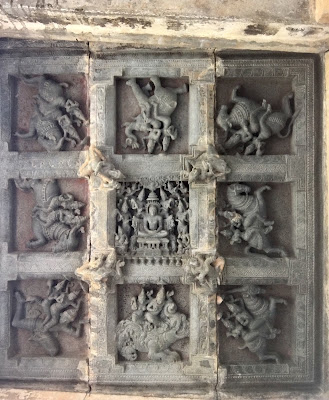Propitiating a force of Nature or a Natural Phenomenon , observed to affect human life in some way, was one of principles of early Religiosity or Spiritualism . To be surrounded by or enveloped within the benevolence of these Forces was a much desired goal and installing a "divinity" as a Guardian in every direction ensured a sense of security .
Guardian spirits were assigned to the four cardinal directions and the four intermediary directions and early structural temples usually depicted them on the ceiling , in a grid surrounding the presiding deity . Two more directions, Upper and Lower or Zenith and Nadir , called Urdhva and Adhah in Sanskrit guarded by Brahma and Vishnu respectively, are omitted from the grid. The Dikpalas are depicted as male and with their preferred mount . In some sites, the panels show them accompanied by consorts.
In Karnataka, Temples built by the Western Gangas and Nolambas have very finely worked bas-relief panels on ceilings dedicated to the Guardians . The best Ashtadikpala ceiling grid , anywhere in India, is found in a humble , unpretentious shrine to Kalleshwara in Aralaguppe, Tumkur District . It is a Nolamba masterpiece .
The Hoysalas made large , ornate sculptures in the round and placed them on the walls alongside other deities. Later , during Vijayanagara times, the Guardians came to occupy frames in the lower portion of pillars .
These are the Dikpalas ( Ashta-dik-palakas = Guardians of the 8 Directions) carved on the ceiling of Bharatalingeshwara trmple in Avani, Kolar dist. Creation of the Nolambas .
The central panel shows the DivineFamily : Shiva, Parvathi and Ganesha, with Nandi under Shiva's foot.
1. Indra guards East . Indra's vahana is Iravatham, the White Elephant which is symbol of royal strength. The attribute he carries is the Vajra ( thunderbolt) and his Consort is Sachi .
3. Kubera guards North ( Uttara or Udici in Sanskrit) . The vahana of Kubera is Nara (Man) , Horse or a even a Goat. It varies by region. His attribute is Gada ( the Mace) and his Consort is Bhadra .
4. Yama guards South( Dakshina in Sanskrit). His vahana is a Water-Buffalo. His attribute is Pasam ( ropes) and his Consort , Dhumorna.
5. Agni guards South East ( Aagneya in Sanskrit) . Agni , who can also be depicted as having two faces, rides a Ram and his attribute is Danda ( a staff) . His consort is Svaaha.
6. Nirutti guards Southwest ( Nairritya in Sanskrit) . Nirutti ( aka Nrtti or Nairutta), called overlord of the Demons , has for a Vahana , a Man or Ghoul . Though generally shown in art as a male, Nirtti is also known as a form of Parvathi . a female Dikpala. The attribute is Khadga ( Sword) .
7. Vayu guards Northwest ( Vaayavya in Sanskrit). Vayu's vahana is a Deer . Attribute is Ankusha (a Goad) . Consort is Lehari .
8. Isana guards Northeast ( Ishanyain Sanskrit). Isana has Vrishbha (bull) as his vahana . Attribute is Trishula ( Trident) and Consort is Ishani.
Depictions down the ages :
The entire ceiling grid , with the Jina as central panel, at Kambadahalli Basadi - a creation of Western Ganga artisans. At the four intersections are seen celestial musicians . 9th Century CE.
A large sized Hoysala example from Kedareshwara Temple, Nagalapura. Varuna , with Consort , riding the Makara ( mythical aquatic animal ) , as a niche figure on the outer wall. In addition to having the Guardians in ceiling grids , the Hoysalas also magnified the Guardians and arranged them on the outer walls , on par with other figures from Mythology . 13th Cent CE.
A post - Vijayanagara period depiction of bicephalous Agni riding a Ram, as a pillar decoration , in the octogonal pavilion by the temple tank in Melkote. The other Guardians occupy other Pillars , at their relevant direction. 16-17th Cent CE.
More recent , as Wodeyar period Stucco figures , arranged on the outer walls , each in own niche : Niruttti , Yama and Agni , in Srikanteshwara Temple, Nanjangud. 18-19th Cent CE.

















No comments:
Post a Comment